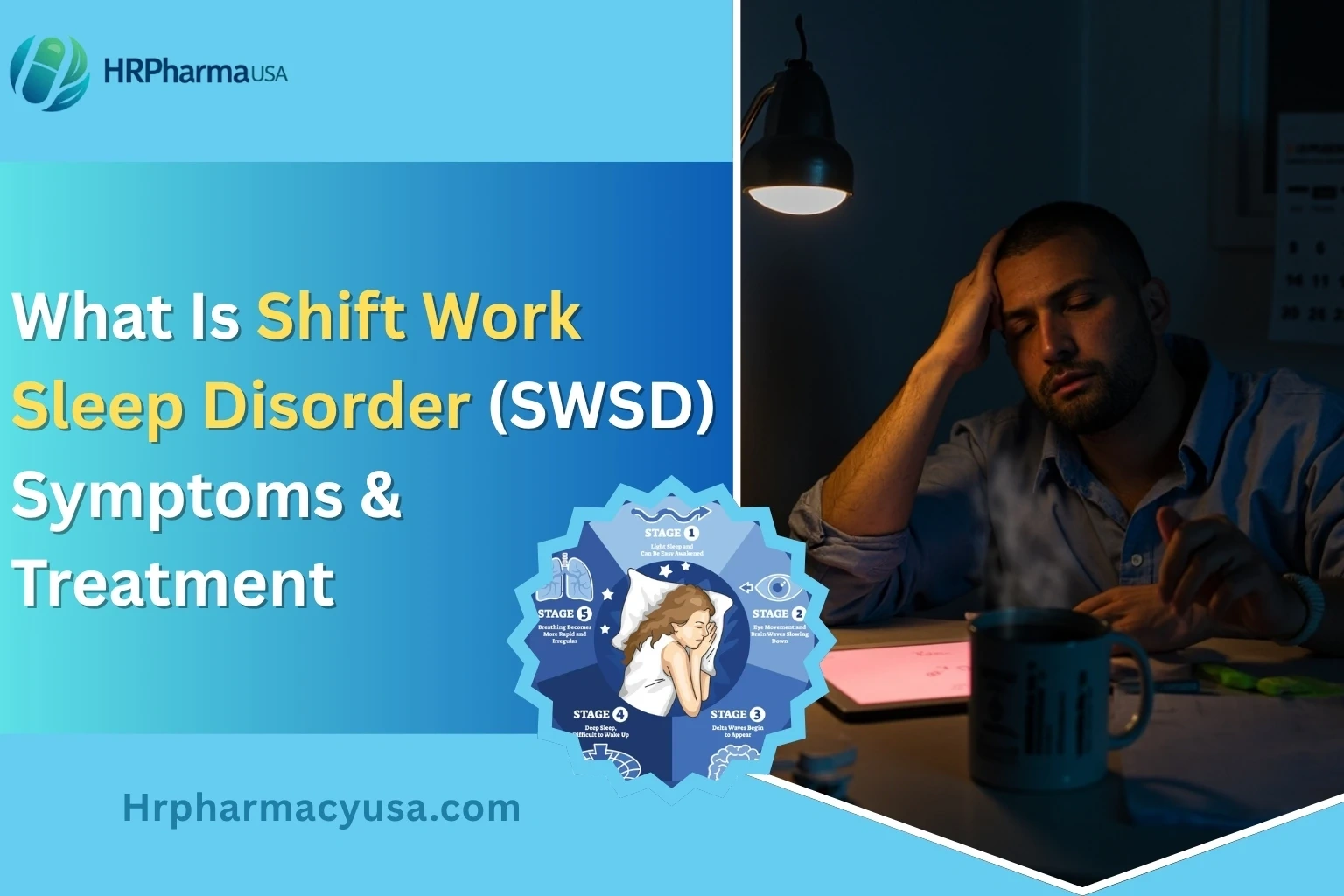Those who work non-traditional hours—including night shifts, rotating shifts, or early morning shifts—may develop Shift Work Sleep Disorder (SWSD). Those with SWSD frequently find it challenging to get enough restorative sleep, which can seriously affect their general health and well-being. This blog post will go over SWSD’s definition, symptoms, and treatment options. We will also discuss whether SWSD qualifies as a disability and explore the ICD-10 coding for the illness.
What Is Shift Work Sleep Disorder (SWSD)?
A medical disorder called sleep disorder results from irregular working hours, upsetting a person’s sleep pattern. This covers positions requiring rotating shifts and early morning or night calls. Poor sleep quality brought on by the disorder causes daytime tiredness, mood swings, and trouble focusing. Shift work is relatively standard in American businesses, including manufacturing, transportation, law enforcement, and healthcare.
The internal clock of the human body, sometimes referred to as the circadian rhythm, is inherently timed with a day-night cycle. Along with other essential functions, this internal clock controls hormone production and the sleep-wake cycle of the body. Working outside these regular hours causes a mismatch in the body’s circadian rhythm that results in trouble falling asleep and staying asleep.
Who Is at Risk for SWSD?
Those who routinely work odd hours often have SWSD. These comprise:
- Night shift working healthcare professionals, including doctors and nurses
- Truck drivers and other rotating-shift transportation employees
- Early or late-hour workers in the service sector and factories
- Police, firefighters, and emergency response teams
Many times, when workers’ bodies naturally want to relax, these professions demand that they be awake and alert.
Symptoms of Shift Work Sleep Disorder
There are several ways shift work sleep disorder might show up. Usually arising from disturbed sleep patterns, the symptoms can seriously affect a person’s quality of life. Typical SWD symptoms are:
1. Insomnia
Insomnia is among SWD’s most noticeable symptoms. Those who work late or night shifts may find it difficult to fall asleep when they get home following their shift. Their internal body clock is off-aligned, which makes daily restful sleep challenging.
2. Excessive Daytime Sleepiness
Another major complaint is too much daytime tiredness. People with SWSD sometimes find it difficult to remain awake either during or after their shifts. This can be dangerous, particularly for people in professions like truck drivers, pilots, or doctors who demand focus.
3. Fatigue
Regardless of how much they sleep, people with SWSD often feel exhausted all the time. Their body’s inability to get quality, restorative sleep because of their irregular work hours causes this chronic tiredness.
4. Mood Swings and Irritability
One’s attitude can be much changed by lack of sleep. SWSD sufferers could have anxiety, depression, and irritability. This can affect their interactions with friends and family as well as their output at work.
5. Difficulty Concentrating
SWSD can affect cognitive functions such as memory, concentration, and problem-solving abilities. This is particularly concerning for workers in critical jobs, where focus and alertness are vital for safety and efficiency.
6. Gastrointestinal Problems
Some SWDs have stomach problems, including constipation, bloating, and indigestion. These problems can result from disrupted circadian rhythms and irregular eating patterns.
ICD-10 Shift Work Sleep Disorder Code
Healthcare professionals code all diagnoses, symptoms, and treatments using the International Classification of Diseases (ICD). The ICD-10 code used in Shift Work Sleep Disorder is G47.20. Doctors and other medical experts use this code when diagnosing SWD, which belongs to the category of sleep problems. The ICD-10 code guarantees correct classification and documentation for treatment-related needs.
Is Shift Work Sleep Disorder a Disability?
Many SWSD sufferers would be unsure whether their illness qualifies as a disability. The degree of the condition and how it affects the person’s capacity for daily functioning will determine the response.
Under the Americans with Disabilities Act (ADA), generally, SWSD is not automatically regarded as a handicap. On the other hand, someone may be entitled to disability accommodations if their condition is severe enough to keep them from living an everyday life or completing necessary chores at employment. SWSD’s symptoms—such as extreme tiredness and mood swings—can interfere with a person’s capacity to concentrate, focus, and finish their work. Sometimes, employees with SWSD ask for changes to their shifts or flexible schedules.
Depending on their particular circumstances and how SWSD affects their quality of life, people may be qualified for disability benefits if it seriously impairs daily functioning.
Treatment for Shift Work Sleep Disorder
Although there is no one-size-fits-all solution for SWSD, several techniques can help reduce the symptoms and enhance the quality of life for persons living with the disorder. These are some of the best remedies for shift work sleep disorder:

1. Sleep Hygiene Practices
Changing good sleeping habits is one of the first steps towards controlling SWD. This covers designing a sleeping space and developing a regular sleep schedule. Some pointers on good sleep hygiene consist of the following:
- Keeping the bedroom cool, dark, and quiet
- Limiting caffeine and alcohol intake before sleep
- Avoiding electronic devices (phones, laptops) before bedtime
- Going to bed and waking up at the same time every day, even on days off
- Taking short naps during the day to reduce fatigue
2. Bright Light Therapy
Bright light therapy exposes the person to strong light at designated times to help reset the circadian rhythm. Those who work nights especially find this helpful. Bright light therapy enhances daytime sleep quality by helping the body signal when it’s time to be awake and alert.
3. Cognitive Behavioral Therapy for Insomnia (CBT-I)
Cognitive behavioral therapy for insomnia (CBT-I) is a structured treatment that helps people overcome sleep disturbances by addressing negative thoughts and behaviors connected with sleep. For those with SWSD, CBT-I has been shown to be successful and can help increase both sleep quality and length.
4. Melatonin Supplements
One hormone that helps to control sleep is melatonin. Melatonin pills taken at the correct time can enable SWD sufferers to fall asleep faster and enhance the quality of their sleep. Before using melatonin, one should see a medical practitioner since the dosage and timing vary depending on the work schedule of the individual.
5. Medication
Sometimes, doctors will prescribe drugs like Modafinil to enable people with SWD to stay awake during their shifts or sleep better. Among these drugs can be stimulants or sleep aids. Still, drugs are usually regarded as a last resort; non-pharmacological therapies should be tried first.
6. Lifestyle Changes
Changing lifestyle choices, including eating a healthy diet and consistent exercise, will also help control SWD symptoms. While a healthy diet can help sustain energy levels all day, regular physical activity can encourage better sleep.
FAQs,
1. What are the main causes of shift work sleep disorder?
SWSD is caused by a misalignment between the body’s natural circadian rhythm and the work schedule. People who work night shifts, rotating shifts, or irregular hours disrupt their sleep-wake cycle, leading to poor sleep quality and excessive daytime fatigue.
2. Can shift work sleep disorder be prevented?
While it may not be entirely preventable, certain strategies, such as improving sleep hygiene and using bright light therapy, can help reduce the impact of shift work on sleep patterns. Also using prescribed medications to help you treat shift work sleep disorder.
3. Is it possible to adapt to night shift work?
Over time, some individuals may adapt to night shifts by gradually adjusting their sleep schedule. However, the adaptation process can take several weeks, and some people may never fully adjust, continuing to experience symptoms of SWSD.
4. Are there long-term effects of shift work sleep disorder?
Yes, prolonged SWSD can lead to long-term health issues, including cardiovascular problems, gastrointestinal disorders, and an increased risk of depression and anxiety. Therefore, it is important to address the symptoms of SWSD early on.
5. Can SWSD be treated without medication?
Yes, many individuals with SWSD find relief through lifestyle changes, improved sleep hygiene, and cognitive behavioral therapy. Medications are typically considered only when other treatments are ineffective.
Conclusion
In summary, people who work non-traditional hours suffer from shift work sleep disorder (SWSD). It can throw off the body’s natural circadian rhythm and bring about symptoms, including mood swings, insomnia, too much daytime sleepiness, and tiredness. Although SWSD is not automatically regarded as a handicap, those who suffer significant impairment could be qualified for concessions. Improving sleep hygiene, light therapy, cognitive behavioral therapy, and occasionally medication are treatments for SWSD. Those with SWSD can control their symptoms and raise their general quality of living with the correct techniques.



